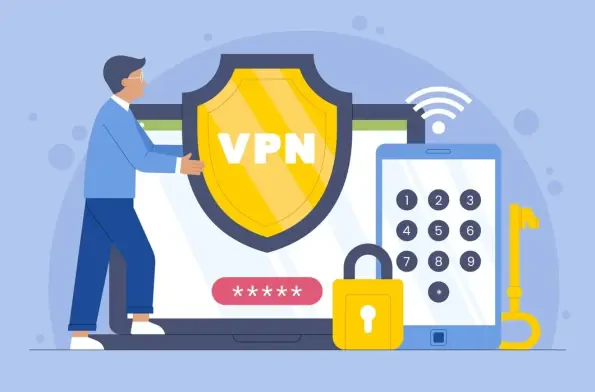In an era where cyber threats grow more sophisticated by the day, organizations face unprecedented challenges in securing remote access across hybrid and multi-cloud environments, and Virtual Private Networks (VPNs), once hailed as the gold standard for protecting data in transit, are increasingly unable to keep pace with the demands of modern IT ecosystems. Originally engineered for a perimeter-based security model, VPNs struggle to address the dynamic, distributed nature of today’s infrastructures, leaving critical vulnerabilities exposed. As cyber attackers exploit these weaknesses with alarming frequency, the need for a more robust and adaptive approach becomes undeniable. This exploration uncovers the fundamental flaws in VPN technology, from security gaps to operational inefficiencies, and introduces KeeperPAM®, a cloud-native Privileged Access Management (PAM) platform, as a transformative solution designed to meet the stringent security requirements of contemporary digital landscapes.
Unmasking the Weaknesses of VPN Technology
The foundation of VPNs was laid in a time when safeguarding a defined network boundary was sufficient to protect organizational assets. However, the shift to hybrid and multi-cloud systems has rendered this legacy architecture obsolete, creating significant security gaps that attackers are quick to exploit. VPNs often provide users with broad network access, disregarding the Principle of Least Privilege (PoLP), which dictates that individuals should only have the permissions necessary for their roles. Such overexposure dramatically increases the attack surface, making it easier for unauthorized access to occur and for data breaches to spiral out of control. As organizations expand beyond traditional boundaries, the mismatch between VPN capabilities and the complexities of modern IT environments becomes a glaring liability, highlighting the urgent need for a security model that prioritizes granular control over blanket access.
Beyond the inherent design flaws, VPNs also struggle to deliver the operational efficiency required by today’s remote and distributed workforces. Performance issues such as latency often plague VPN connections, especially as the number of remote users scales up, leading to frustration and productivity losses. Maintaining VPN infrastructure demands substantial resources, with complex configurations and constant updates draining IT teams’ time and budgets. Furthermore, the lack of robust monitoring tools in traditional VPN setups hampers real-time visibility into user activities, posing significant challenges for compliance and auditing. Regulatory requirements are becoming stricter, and without adequate tools to track and record access, organizations risk falling short of standards, facing penalties, and damaging their reputations. These operational shortcomings compound the security risks, painting a clear picture of why VPNs are no longer a sustainable solution for modern cybersecurity needs.
Exposing Critical Risks in VPN Access
One of the most pressing dangers associated with VPNs lies in their vulnerability to credential theft and compromised devices, which can have catastrophic consequences for organizational security. If a user’s login details are stolen or a device becomes infected with malware, attackers can gain VPN access with relative ease, often moving laterally across the network to inflict maximum damage. This ability to navigate freely within systems amplifies the impact of a single breach, turning a minor incident into a full-scale crisis. The absence of stringent controls to limit access and monitor behavior leaves organizations exposed to risks that could be mitigated with a more sophisticated security framework, underscoring the inadequacy of VPNs in preventing such threats from materializing.
Additionally, the reliance on VPNs often overlooks the evolving tactics of cybercriminals who continuously adapt to exploit weaknesses in traditional security tools. Many VPN implementations fail to enforce multi-factor authentication or regular credential rotation, leaving static passwords as low-hanging fruit for attackers armed with phishing schemes or brute-force methods. Even when security measures are in place, the lack of integration with broader identity management systems means that compromised credentials can go undetected for extended periods. This blind spot not only jeopardizes sensitive data but also erodes trust in the organization’s ability to safeguard its digital assets. As cyber threats grow in complexity, the limitations of VPNs in addressing these nuanced risks become a critical concern for any forward-thinking enterprise aiming to protect its infrastructure.
KeeperPAM: Redefining Secure Access
In response to the glaring deficiencies of VPNs, KeeperPAM® emerges as a groundbreaking solution tailored to the realities of today’s cybersecurity landscape. Built on a zero-trust framework, this cloud-native platform eliminates the need for traditional VPNs by utilizing outbound-only connections, which reduce the attack surface by avoiding inbound firewall modifications. KeeperPAM introduces just-in-time (JIT) access, granting temporary, role-based permissions that are automatically revoked after use, aligning perfectly with the Principle of Least Privilege. Moreover, post-session credential rotation ensures that sensitive information like passwords and SSH keys remains secure, as users never directly handle these secrets—they are injected into sessions seamlessly. This innovative approach minimizes exposure risks and provides a robust defense against the vulnerabilities that plague VPN-based systems.
KeeperPAM also excels in scalability and adaptability, addressing the diverse needs of modern IT environments with ease. Designed to support secure access across multiple protocols, including SSH, RDP, and web applications, the platform ensures compatibility whether deployed in on-premises, hybrid, or cloud setups. Its cloud-native architecture offers unified management and seamless integration with developer tools, reducing friction for technical teams while maintaining high security standards. Additionally, KeeperPAM records sessions for compliance and auditing purposes without compromising performance, empowering IT administrators with real-time visibility to detect and respond to anomalies swiftly. Unlike VPNs, which falter under the weight of distributed infrastructures, KeeperPAM provides a scalable, efficient solution that evolves with organizational growth and changing security demands.
Charting the Path Forward with Modern PAM
Reflecting on the journey through the shortcomings of VPNs, it becomes evident that their legacy design and operational inefficiencies have left organizations vulnerable to an array of cyber threats. The risks tied to broad access, credential theft, and poor visibility underscore the pressing need for a paradigm shift in securing remote access. KeeperPAM® has proven itself as a formidable alternative, with its zero-trust principles and just-in-time access mechanisms redefining how security can be implemented in complex IT environments. For organizations looking to fortify their defenses, the next step involves evaluating current remote access strategies and identifying areas where traditional tools fall short. Exploring cloud-native PAM solutions like KeeperPAM offers a pathway to not only address existing vulnerabilities but also build a resilient framework capable of adapting to future challenges. Embracing such advanced tools ensures that security evolves in tandem with technology, safeguarding assets in an increasingly perilous digital world.













